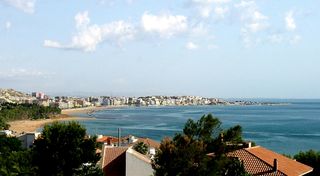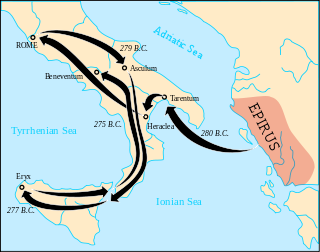
Calabria is a region in southern Italy. It is a peninsula bordered by Basilicata to the north, the Ionian Sea to the east, the Strait of Messina to the southwest, which separates it from Sicily, and the Tyrrhenian Sea to the west. It has almost 2 million residents across a total area of 15,222 km2 (5,877 sq mi). Catanzaro is the region's capital.

Reggio di Calabria, commonly and officially referred to as Reggio Calabria, or simply Reggio by its inhabitants, is the largest city in Calabria as well as the seat of the Regional Council of Calabria. It has an estimated population between 150,000 and 200,000 and is the twenty-first most populous city in Italy, after Modena and other Italian cities, and the 100th most populated city in Europe. Reggio Calabria is located near the center of the Mediterranean and is known for its climate, ethnic and cultural diversity. It is the third economic centre of mainland Southern Italy. About 560,000 people live in the metropolitan area, recognised in 2015 by Italy as a metropolitan city. Sadly, it holds the record of the worst city in terms of quality of life for environmental and cultural parameters, ranking among the worst Italian cities for quality of life.

Magna Graecia is a term that was used for the Greek-speaking areas of Southern Italy, in the present-day Italian regions of Calabria, Apulia, Basilicata, Campania and Sicily; these regions were extensively populated by Greek settlers starting from the 8th century BC.

This is a timeline of ancient Greece from its emergence around 800 BC to its subjection to the Roman Empire in 146 BC.

Crotone is a city and comune in Calabria, Italy.

Sybaris was an important ancient Greek city situated on the coast of the Gulf of Taranto in modern Calabria, Italy.

Epizephyrian Locris, also known as Locri Epizefiri, was an ancient city on the Ionian Sea, founded by Greeks coming from Locris at the beginning of the 7th century BC. It is now in an archaeological park near the modern town of Locri.

The Pyrrhic War was largely fought between the Roman Republic and Pyrrhus, the king of Epirus, who had been asked by the people of the Greek city of Tarentum in southern Italy to help them in their war against the Romans.

The Messapians were an Iapygian tribe who inhabited Salento in classical antiquity. Two other Iapygian tribes, the Peucetians and the Daunians, inhabited central and northern Apulia respectively. All three tribes spoke the Messapian language, but had developed separate archaeological cultures by the seventh century BC. The Messapians lived in the eponymous region Messapia, which extended from Leuca in the southeast to Kailia and Egnatia in the northwest, covering most of the Salento peninsula. This region includes the Province of Lecce and parts of the provinces of Brindisi and Taranto today.
Archon was a Pellaeon, appointed satrap of Babylonia after the death of Alexander the Great in 323 BC. He is probably the same as the son of Cleinias mentioned in the Indian expedition of Alexander. He perished in 321 BC in a fight against Dokimos. An inscription in Delphi shows that Archon had taken part in both the Isthmian and Pythian Games of 333 to 332 BC, won some horse-races.
The Battle of Pandosia was fought in 331 BC between a Greek force led by Alexander I of Epirus against the Lucanians and Bruttians, two southern Italic tribes. The Italic army soundly defeated the invading Greeks and killed Alexander I of Epirus during the battle.

Stilo is a town and comune in the province of Reggio Calabria, in the Calabria region of southern Italy. It is 151 kilometres (94 mi) from Reggio.

Heraclea, also Heracleia or Herakleia, was an ancient city. It was situated on the Gulf of Taranto between the rivers Aciris and Siris. The ruins of the city are located in the modern comune of Policoro in the Province of Matera, Basilicata, Italy.
Sybaris on the Traeis was an ancient city situated on the Traeis river, now known as the Trionto. It shares its name with the original city of Sybaris which was destroyed in 510 BC. Its former inhabitants built a new city, Thurii, not far from the site of Sybaris. This new colony was founded together with other Greek settlers in 446/445 BC. Soon a conflict arose between the two groups and most of the Sybarites were killed by the other Greek colonists of Thurii. The Sybarites who managed to flee then founded Sybaris on the Traeis a short time after 444 BC. The city was destroyed by the Bruttii not long after their emergence as an ethnic group in 356/355 BC.

The Vallata dello Stilaro is a valley in the Province of Reggio Calabria of Southern Italy. It takes its name from river that flow in the area, the Stilaro.

The Museo Nazionale della Magna Grecia, Museo Archeologico Nazionale di Reggio Calabria or Palazzo Piacentini is a museum in Reggio Calabria, southern Italy, housing an archaeological collection from sites in Magna Graecia.

Terina was an ancient city located on the Piano di Tirena hill in Nocera Terinese about 20 km (12 mi) from Lamezia Terme in Calabria. The site of the city was allegedly found in 1922 by the archaeologist Paolo Orsi near the modern village of Sant'Eufemia Vetere. A systematic archaeological investigation was made from 1997 and coins, inscriptions and other artefacts retrieved from the site can be seen in the Museo Archeologico Lametino in Lamezia Terme.

Tauriana or Taureana was an ancient city located in present Palmi, Reggio Calabria province.
Temesa, later called Tempsa, was an ancient city in Italy, on the shore of the Tyrrhenian Sea. It was situated close to Terina, but its precise location has not yet been found. It is thought to have been located near the Savuto river to the north of the Gulf of Sant'Euphemia. More recently Campora San Giovanni, a town near the mouth of the Savuto, has been considered as a more precise location. The archeologist Gioacchino Francesco La Torre excavated a temple outside the town in the early 2000s, which was within the territory of Temesa.

Caulonia or Caulon was an ancient city on the shore of the Ionian Sea near Monasterace, Italy.
















